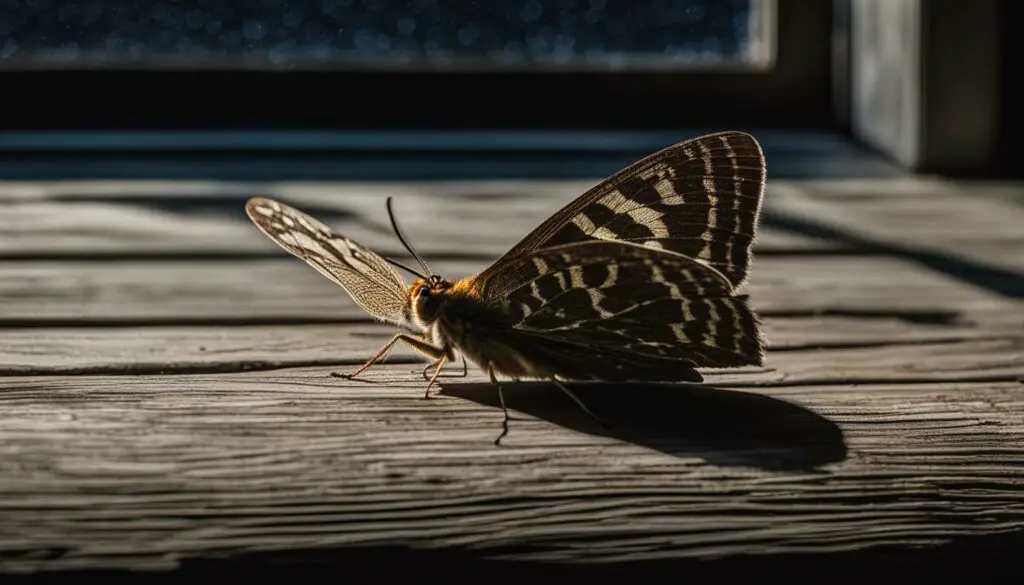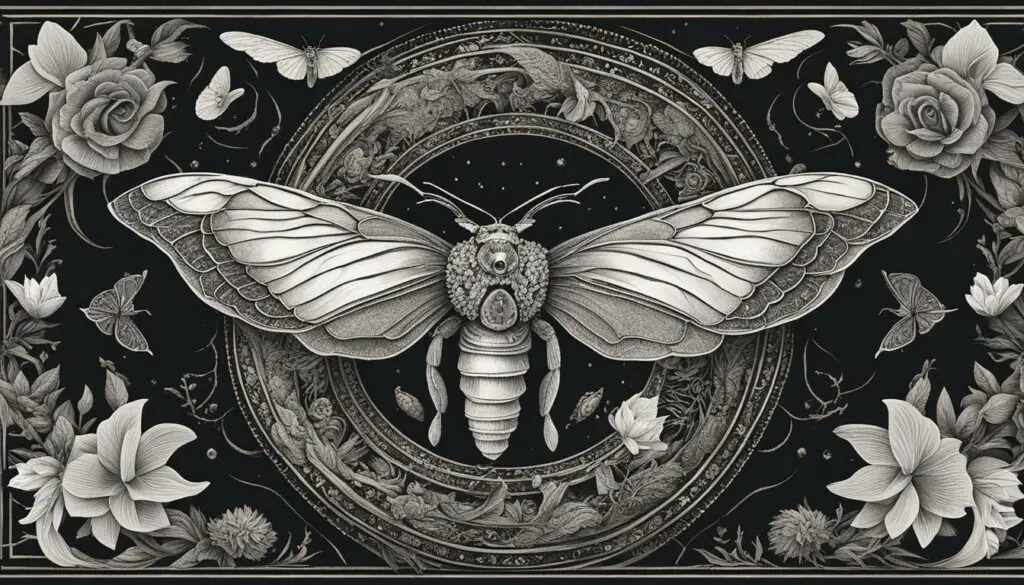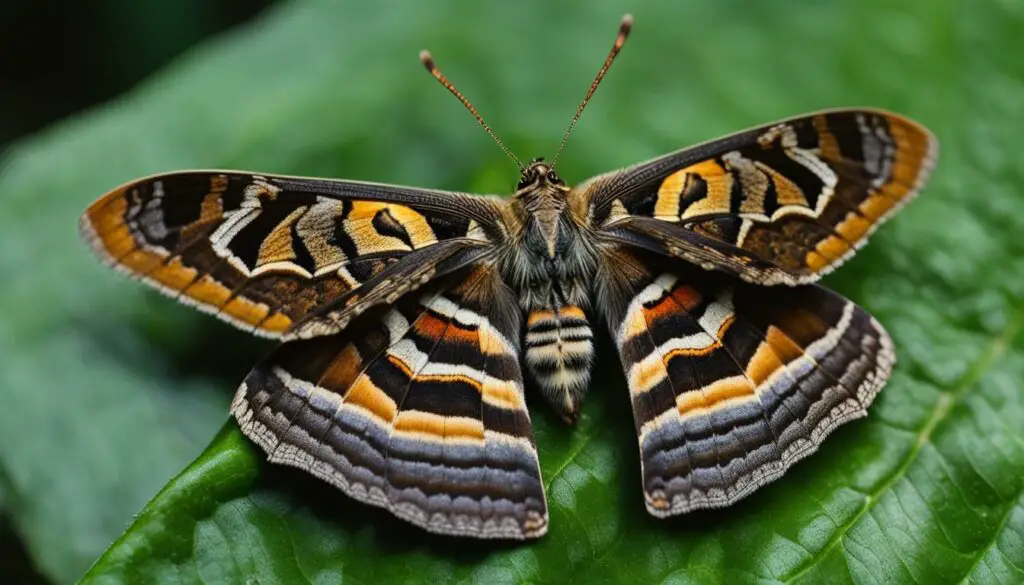Originally posted on November 15, 2023 @ 3:51 am
For generations, people have believed in the superstition that killing a moth brings bad luck. But is there any truth to this age-old belief?
In this article, we will explore the cultural beliefs and symbolism surrounding moths, and delve into the reasons behind the taboo of killing them. From moth folklore and legends to spiritual perspectives, we will examine the many facets of this intriguing subject.
But before we delve into the depths of moth symbolism and superstitions, let’s first address the question on everyone’s mind – is it really bad luck to kill a moth?
The answer is not as straightforward as one might think. While some cultures believe that killing a moth can lead to negative consequences, others view it as a harmless act. Ultimately, the significance of killing a moth depends on one’s cultural beliefs and individual perspective.
Key Takeaways
- The belief that killing a moth brings bad luck is rooted in various superstitions and cultural beliefs.
- There is no universal answer to whether killing a moth is bad luck, as it depends on individual beliefs and cultural nuances.
- In this article, we will explore the symbolism, folklore, and spiritual perspectives surrounding moths to gain a better understanding of this intriguing topic.
- Alternative options exist for those who do not wish to harm moths, such as conservation and removal techniques.
- Ultimately, we can strive for coexistence and respect for these enchanting creatures in our world.
Moth Symbolism and Superstitions

Moths have long been associated with symbolism and superstitions across different cultures. From their appearance to their behavior, these delicate creatures have drawn various interpretations that have shaped beliefs about the consequences of killing them. In this section, we will explore the significance of moth symbolism and delve into the beliefs that have led to the notion of bad luck when killing a moth.
Appearance and Behavior
The appearance and behavior of moths have contributed to various beliefs and superstitions. The most common interpretation is that moths represent transformation and spiritual growth, as they undergo a metamorphosis from a larva to a winged adult. Some cultures believe that moths are messengers from the spirit world or a symbol of the soul’s journey.
On the other hand, the nocturnal behavior of moths has led to negative associations in some cultures. The attraction of moths to light sources has led to the belief that they are drawn to the flame and, therefore, represent a bad omen. For instance, some cultures believe that killing a moth attracts misfortune or signals the arrival of death.
Beliefs and Superstitions
The beliefs and superstitions surrounding killing moths vary across cultures and traditions. In some cultures, killing a moth is believed to bring bad luck or is regarded as taboo. For example, in Indian culture, it is believed that killing a moth brings financial trouble to the household, while in Chinese culture, it is believed that killing a moth can cause the death of a family member.
On the other hand, some cultures see moths as a sign of good luck and regard them with reverence. For instance, in some Native American cultures, moths are seen as protective spirits that ward off negative energies.
Conclusion
The symbolism and superstitions surrounding moths have contributed to the beliefs and taboos surrounding the act of killing them. While some cultures view moths as spiritual messengers and symbols of transformation, others see them as harbingers of death or bad luck. Understanding the significance of moth symbolism can help us cultivate a greater appreciation for these delicate creatures and their role in shaping our beliefs and perceptions.
Folklore and Legends Around Moths

Moths have captured the imaginations and folklore of cultures across the world, from ancient Greece to contemporary Japan. In some cultures, moths are seen as the souls of the departed. One tale from China tells of a man who tried to kill a moth that had flown into his lamp, but was stopped by his wife because she believed the moth was the soul of her deceased mother. Killing it would bring great misfortune.
Native American tribes have their own beliefs about moths. The Hopi people of Arizona see moths as messengers of death, while the Zuni tribe sees them as symbols of transformation. In many African cultures, moths are associated with witchcraft and are thought to bring bad luck if killed.
European folklore also has many legends about moths. In England, it is said that if a white moth enters your home, it is a sign of good luck. However, if a brown moth enters, it is a warning of impending death. The symbolism of moths in literature is also evident, with famous authors such as Virginia Woolf and Nathaniel Hawthorne using them as symbols of mortality and transformation in their works.
It is clear that the symbolism of moths has deeply influenced the beliefs of different cultures. Understanding the significance of these stories can give context to why killing a moth is considered bad luck in many cultures.
“Moths are creatures of the night, and many cultures associate night-time creatures with darkness, mystery, and the unknown. The symbolism of moths has evolved over time, but they remain fascinating and mysterious creatures that spark our imaginations.”
The Spiritual Significance of Killing a Moth

Many spiritual beliefs attribute deeper meaning to the act of killing a moth. In some cultures, killing a moth is seen as a bad omen, bringing misfortune and death. For instance, in Native American folklore, moths are often associated with death and are seen as a messenger of the afterlife. Similarly, in some African tribes, killing a moth is believed to anger the spirits and bring about illness and misfortune.
On the other hand, some spiritual beliefs view moths as a symbol of transformation and rebirth. Killing a moth, in this context, may represent a missed opportunity for growth and change, or signify a resistance to leaving old habits behind. The consequences of killing a moth, then, are believed to manifest as missed opportunities or stagnation in one’s personal growth.
It’s important to note that these spiritual beliefs are deeply ingrained in certain cultures and should be respected. Whether or not one personally subscribes to these beliefs, it’s crucial to respect the taboos surrounding the act of killing a moth and to consider the consequences of one’s actions.
“It’s important to respect the taboos surrounding the act of killing a moth and to consider the consequences of one’s actions.”
Understanding Moth Behavior and Habitats

Moths are fascinating creatures that play several essential roles in our ecosystem. Understanding their behavior and habitats is critical to appreciating their importance and appreciating their unique beauty.
There are over 160,000 species of moths globally, and they are found in almost every habitat, from arctic tundra to deserts, grasslands, forests, and wetlands. Moths can be divided into two broad groups: macro and micro moths. Macro moths are typically larger, and some species are more colorful than micro moths. Micro moths are often tiny and less noticeable. The common clothes moth is an example of a macro moth, while the pyralid moth is a micro moth.
Moths have several behaviors that allow them to thrive in their natural environments. Their most notable and well-known feature is their attraction to light. Moths have phototaxis, which means they are drawn towards light sources. This behavior can create issues in urban areas because artificial lights can confuse the moths and cause them to become disoriented.
Another essential aspect of moth behavior is their role in pollination. Moths are critical pollinators, particularly for night-blooming plants that rely on pollination at night. In addition, many moth species serve as a food source for other animals in the ecosystem, including birds, bats, and other insects.
Moth Habitats
Moths can be found in almost every habitat, from the tropics to the arctic. The specific habitat a species inhabits depends on its particular biological requirements, such as the type of food it needs to survive and the temperature and humidity levels required for its development and growth.
Some moth species live in specific environments such as forests, while others can be found in more diverse habitats like grasslands. Some of the most common moth habitats include:
| Habitat Type | Description |
|---|---|
| Forests | Forests provide an ideal habitat for many different species of moths. The diversity of plant life in forests provides ample food sources for several species. |
| Grasslands | Grasslands and prairies provide habitat for a diverse range of moth species. Many species prefer to inhabit grassy areas, and some species rely on specific grasses for their survival. |
| Wetlands | Wetlands are another important habitat for moths, particularly those that rely on specific plants to survive. |
| Deserts | Some moth species inhabit the arid conditions of desert environments and have adapted to the harsh conditions there. |
Overall, understanding moth behavior and habitats is critical to preserving these essential creatures’ role in our ecosystem. By appreciating their ecological importance, we can learn to coexist and respect their place in nature.
Debunking Common Myths about Moths

There are many myths surrounding moths that often lead to misconceptions about these fascinating creatures. It’s time to debunk some of the most common myths about moths:
- Myth: Moths are just boring, drab versions of butterflies.
- Fact: Moths come in a wide variety of shapes, sizes, and colors, some of which are just as vibrant and beautiful as butterflies.
- Myth: All moths are nocturnal and only fly at night.
- Fact: While many moth species are indeed nocturnal, there are also plenty of diurnal (day-flying) moths.
- Myth: Moths are attracted to light because they mistake it for the moon.
- Fact: Moths are actually using light as a form of navigation, as they tend to fly in a straight line and use the light source to stay on course. This behavior leads them to be attracted to artificial lights at night, which can be harmful to their survival.
- Myth: All moths eat clothing and other fabrics.
- Fact: There are only a few species of moths that feed on fabrics, most notably the clothes moth. The majority of moths are harmless and do not feed on clothing or textiles.
- Myth: Moths are pests that should be exterminated.
- Fact: While some species of moths can cause damage to crops or fabrics, the majority of moths play an essential role in the ecosystem as pollinators and food sources for other animals.
So why do these myths persist?
Many of these myths stem from cultural beliefs and superstitions, as well as a lack of understanding about the diverse characteristics and behaviors of moths. By educating ourselves about the truth behind these myths, we can develop a deeper appreciation for the important role moths play in our world.
Cultural Variances in Beliefs about Moths

The beliefs and superstitions surrounding the killing of moths vary greatly between cultures and regions. In some cultures, moths are considered sacred creatures and are believed to bring good luck, while in others, they are associated with death and considered evil omens.
In Asian cultures, for example, the killing of moths is discouraged as it is believed to bring bad luck and may even harm one’s ancestors. Some African cultures see moths as messengers of death and believe that killing them may bring misfortune and tragedy. Meanwhile, in Western cultures, the killing of moths is often considered a mundane task, with no particular significance attached to it.
These cultural beliefs are deeply ingrained and may even manifest in certain rituals or taboos surrounding the killing of moths. It is important to respect these beliefs and approach the topic with an open mind and a willingness to learn.
Examples of Cultural Beliefs Surrounding Killing Moths
| Culture/Region | Beliefs about Killing Moths |
|---|---|
| Chinese | Killing a moth may harm one’s ancestors and bring bad luck. |
| African | Moths are seen as messengers of death, and killing them may bring misfortune. |
| Native American | Moths are seen as symbols of transformation and spiritual growth. Killing them may block one’s spiritual journey. |
It is essential to understand these varied cultural beliefs and approach them with respect and sensitivity. By doing so, we can cultivate a greater appreciation for the diverse perspectives that make up our world.
Harmless Alternatives: Moth Conservation and Removal

While it may be tempting to swat a moth with a nearby magazine or shoe, the repercussions of killing a moth can extend beyond just superstition. In many cultures, killing a moth is considered taboo and disrespectful to these delicate creatures of the night.
But fear not, for there are harmless alternatives to dealing with moths in your home or outdoor space. Moth conservation is one approach that allows you to coexist with these creatures while maintaining a healthy environment. By creating a moth-friendly space with natural habitats and food sources, you can attract moths to areas where they can thrive without causing any harm.
For those who prefer not to have moths in their living spaces, there are various removal techniques available that do not involve killing the moth. Using a glass and paper, you can gently catch and release moths back into the wild. There are also humane moth traps available that use pheromones to lure moths in without harming them.
Remember, moths play an essential role in the ecosystem and are important pollinators and food sources for other animals. By respecting these creatures and finding ways to coexist peacefully with them, we can create a harmonious balance in our environment.
How Moths Benefit the Ecosystem

Moths are often viewed as pests, but in reality, they play a crucial role in our ecosystem. Let’s dive into some of the ways moths contribute to our environment:
| Benefit | Description |
|---|---|
| Pollination | Moths, like butterflies, are important pollinators. They help to fertilize plants and support the growth of various ecosystems. |
| Food Source | Moths serve as a primary food source for many animals, including birds, bats, and other insects. They contribute to the food chain by providing sustenance for larger creatures. |
| Decomposition | When moths die or shed their wings, their bodies contribute to the nitrogen and other nutrients in the soil. This process helps to support plant growth and enrich the ecosystem. |
| Biodiversity | Moths are a diverse and unique species that help to enrich the biodiversity of our planet. They exist in various habitats and contribute to the delicate balance of nature. |
| Predator Repellant | Some moth species secrete chemicals that repel predators, protecting themselves and other species in the ecosystem from harm. |
As we can see, moths are far from being just pests. They serve as valuable members of our ecosystem, contributing to biodiversity, providing food sources, and helping to fertilize plants. By understanding their importance, we can learn to appreciate these delicate creatures and the role they play in the world around us.
Finding Harmony with Moths: Coexistence and Respect
Instead of fearing or killing moths, it is possible to peacefully coexist with these fascinating creatures. Here are some tips:
- Lighting: Moths are attracted to bright lights. Consider using dimmer outdoor lighting or turning off unnecessary indoor lights to minimize the number of moths attracted to your space.
- Moth Houses: Provide a safe and cozy home for moths by creating a moth house. A simple and effective solution is to hang a piece of burlap or a wooden box with small holes in a tree or on a wall. This will give moths a place to rest, breed, and hibernate.
- Gardening: Planting moth-friendly flowers, such as lavender, jasmine, and petunias, can provide nectar for adult moths and a habitat for their larvae. Avoid using harmful pesticides that could harm moths and other insects in your garden.
- Cleaning: Regularly clean and vacuum your home to reduce the likelihood of moth infestations. Store clothes and other fabrics in airtight containers or bags.
Remember that moths play an important role in the ecosystem, serving as food for other animals and pollinating plants. Rather than seeing them as pests, we can appreciate their unique beauty and contribution to our environment.
Conclusion
As we have seen, killing a moth has long been associated with bad luck and negative consequences in various cultures and superstitions. However, by delving deeper into the symbolism, folklore, and benefits of moths, we can begin to reshape our perspective and cultivate a greater appreciation for these enchanting creatures.
The Importance of Understanding Moth Behavior
One key aspect of appreciating moths is understanding their behavior and natural habitats. By gaining a deeper understanding of these fascinating creatures, we can avoid unintentionally causing harm and learn to coexist peacefully with moths in our environments.
Debunking Myths and Changing Perceptions
Another way to shift our perspective on moths is by debunking common myths and misconceptions. By separating fact from fiction and gaining a more accurate understanding of moths, we can begin to see these creatures in a more positive light.
Respecting and Coexisting with Moths
Ultimately, the key to finding harmony with moths is through respect and coexistence. By valuing the contributions moths make to our ecosystem and recognizing their unique beauty, we can learn to peacefully share our spaces and appreciate the delicate balance of nature.
So the next time you encounter a moth, instead of reaching for a fly swatter or feeling anxious about potential bad luck, take a moment to appreciate the beauty and significance of these fascinating creatures. By doing so, you may just find yourself on a path towards greater harmony with the world around you.
FAQ
Is it bad luck to kill a moth?
The belief that killing a moth brings bad luck is rooted in various superstitions and cultural beliefs. While there is no scientific evidence to support this notion, it is important to consider the symbolism and cultural significance surrounding moths.
What are some common superstitions about killing moths?
Common superstitions include the idea that killing a moth can bring financial loss, illness, or even the death of a loved one. These beliefs vary across different cultures and regions.
What is the significance of moths in symbolism and superstitions?
Moths are often associated with transformation, intuition, and vulnerability. They are seen as creatures of the night, representing a bridge between the physical and spiritual realms.
Are there any folklore or legends surrounding moths?
Yes, moths have been the subject of many intriguing folklore and legends. In some cultures, they are believed to be messengers from the spirit world or even beings that can grant wishes.
Do different cultures have different beliefs about killing moths?
Yes, cultural beliefs surrounding killing moths can vary greatly. Some cultures view moths as symbols of good luck and protection, while others associate them with death or illness.
What is the spiritual significance of killing a moth?
Some spiritual beliefs suggest that killing a moth can disrupt energetic harmony and attract negative energy. It is believed to have consequences on one’s spiritual well-being.
What should I do if I don’t want to kill a moth?
There are harmless alternatives to killing moths. You can try guiding them outside or using moth conservation and removal techniques to peacefully coexist with these creatures.
How do moths benefit the ecosystem?
Moths play an important role in pollination and serve as a food source for other animals. They also contribute to nutrient cycling and help maintain a balanced ecosystem.
How can I find harmony and respect for moths?
Instead of fearing or killing moths, you can strive for coexistence and respect. Appreciate their beauty, refrain from using harmful pesticides, and create moth-friendly environments in your outdoor spaces.
